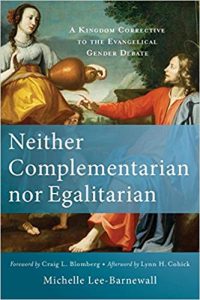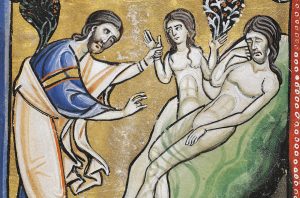For some, talking about the gender of God is pointless. After all, what good can come from such a conversation? Doesn’t bringing up “gender” allow for an exclusively male God dictated wholly by the earthly body of Jesus? Isn’t it much more pragmatic (and more biblical) to stick to the safe confines of metaphors?
God is like a father. God is like a mother.
I know it seems strange to say that I’m not completely egalitarian especially since I wholeheartedly believe in the equality of man and woman (equal in worth, purpose, and authority). But there are reasons I don’t perfectly fit the term egalitarian. In fact, I think my professor of Christian feminism said it best when she told me, “A true Christian feminist CANNOT believe in the maleness of Jesus.” That one statement is what sets me apart from some egalitarians.
The fact is I do believe in the maleness of God. In other words, I believe the body of Jesus is important to theology. I believe Jesus has always existed as the “son” of God and that even now “he” exists with his body resurrected and restored to the mysterious glory that he had before the world was created.
There are both heavenly bodies and earthly bodies, but the glory of the heavenly is one thing, and that of the earthly is another…. So it is with the resurrection of the dead. What is sown is perishable, what is raised is imperishable. It is sown in dishonor, it is raised in glory. It is sown in weakness, it is raised in power. It is sown a physical body, it is raised a spiritual body. If there is a physical body, there is also a spiritual body. —1 Cor. 15:40, 42–44 (NRSV)
That being said, I also believe in the femaleness of God — which may come as a surprise to many Christians. Yet, I am not the only one. I have met many egalitarians who also believe in both the maleness and the femaleness of God. For folks like us “gender” and “body image” is not irrelevant nor is gender merely a cultural mechanism on which to stake beliefs of inequality.
In other words, calling God male does not negate the possibility that God is also female. Nor does a male\female God presuppose that a hierarchy exists within God (as though God is inherently patriarchal — patriarchy is our sin not God’s). A dual-gendered God is simply a diverse God — we (male and female) were created to reflect Them.

To the complementarian, gender defines what man and woman’s purpose is — gender is therefore restrictive, may I even say obstructive to freely following the Holy Spirit. For the egalitarian, gender is almost meaningless — placing little weight on the biblical revelation that humans are created in the image and likeness of God. The two sides view gender in very different ways, for the complementarian God is male (usually only male and usually authoritarian) and for the egalitarian God transcends gender as God is spirit and has no form — leaving the body of Jesus to exist not as a literal revelation of who God is, but as a human manifestation in which the invisible God interacts with us.
Is God Genderless?
Recently, an amendment was introduced in the United Methodist Church that would have done away with the maleness of God. If passed, all this talk about a gendered God would fade into the background — at least for the Methodist Church. However, the amendment needed 66.7 percent of the votes to pass and only received 66.5 percent.
The proposed amendment was as follows:
- “As the Holy Scripture reveals, both men and women are made in the image of God and, therefore, men and women are of equal value in the eyes of God. The United Methodist Church recognizes it is contrary to Scripture and to logic to say that God is male or female, as maleness and femaleness are characteristics of human bodies and cultures, not characteristics of the divine. The United Methodist Church acknowledges the long history of discrimination against women and girls. The United Methodist Church shall confront and seek to eliminate discrimination against women and girls, whether in organizations or in individuals, in every facet of its life and in society at large. The United Methodist Church shall work collaboratively with others to address concerns that threaten the cause of women’s and girl’s equality and well-being.”
Advocates for this amendment, those who see value in a genderless God, argued, “It is an affirmation that, as part of our core foundational beliefs, this church will forever stand against any actions, organizations or individuals that discriminate or dehumanize women and girls anywhere on this planet.”
Critics of the amendment took issue with these specific words: “it is contrary to Scripture and to logic to say that God is male or female.”
Ultimately, both sides have valid and logical concerns: those who are pro-amendment want to restore value and honor to women who for too long have been marginalized, penalized, and regulated because of their gender and the perceived insignificance or inferiority that goes along with that gender when it is portrayed alongside an all male God.
And those who are against the amendment also have valid and logical concerns since they don’t necessarily see the female image as not representing God — they may not understand or perceive the female image of God but that doesn’t mean they don’t believe she could exist, but since they do see the male image as significantly portrayed throughout the scriptures, a “male image” can be considered a legitimate and logical representation of God.
Good News magazine responded (March 15, 2017) with these theological concerns:
Positives
- Strong statement in favor of the equal value of women and men in God’s eyes, which we support
- Strong commitment on behalf of the church to seek to eliminate discrimination against women and girls, which we support
Negatives
- This statement reads more like a Social Principle than a paragraph in the Constitution, particularly with its emphasis on theology. We question whether it belongs in the Constitution.
- The second sentence raises theological concerns when it says, “it is contrary to Scripture and to logic to say that God is male or female … maleness and femaleness are … not characteristics of the divine.” Does this mean Jesus is not male? Or does it mean that Jesus, who is obviously male, is not divine? Either position is contrary to our doctrinal standards.
- This language could potentially be used to discourage use of references to God as Father (e.g., hymns, prayers, creeds)
In the end, the problem lies with Jesus (doesn’t that just figure) and more specifically–his male body. Below is a nice, short intro as to why many (myself included) believe God is male, Dr. Michael Heiser discusses God as man in the Old Testament (fast forward to 2:50). F.Y.I I will post more information about the male form of God on this site in the next few months.
If the video does not work GO HERE.(fast forward to 2:50)
As my feminist theology professor once so adamantly pointed out, the maleness of Jesus is highly problematic; after all, it was Jesus’ male body that was said to be “the image of the invisible God, the firstborn of all creation” (Col. 1:15). And it was the male that was killed and then resurrected to life and restored to his former glory:
[Jesus said,] “I glorified you on earth by finishing the work that you gave me to do. So now, Father, glorify me in your own presence with the glory that I had in your presence before the world existed.” –Jn. 17:4-5, bold added, NRSV

Thus it is written, “The first man, Adam, became a living being”; the last Adam became a life-giving spirit. But it is not the spiritual that is first, but the physical, and then the spiritual. The first man was from the earth, a man of dust; the second man is from heaven. –1 Cor. 15:45–47, NRSV, bold added
This is where we (as a church body) tend to fall short. We preach an invisible, unknowable Spirit (the Holy Spirit is NOT always invisible). Or, sometimes we teach that Jesus morphed into an invisible Spirit — as though no body exists at all. As though Jesus and the Spirit are the exact same person — the male image, in this case, overshadows the feminine Spirit so we call the Spirit “he” and we quote 2 Cor. 3:17, “Now the Lord is the Spirit, and where the Spirit of the Lord is, there is freedom.”
But Jesus and the Spirit are not the same person — they are however “one” meaning they are completely united by the bond of love and they are two individuals united in one physical body. So the lord Jesus really is the Spirit. And yet, they are their own persons, known throughout our scriptures for accomplishing different things.
Ultimately, the “image” and the “likeness” of God are represented on earth by two different types of images (1) a male image (Adam) and (2) a female image (Eve). This pair is an earthly metaphor for the God who created the universe. They are living allegories of a very real God. They are like God, so close in person to the God who created them that they are thought of as His/Her very children. And it is precisely because they are like God that the first image (Adam/male) brings about the second image (Eve/female) from his own body just as Jesus releases from within himself the Holy Spirit.
The first man, Adam, became a living being [Eve]”; the last Adam became a life-giving spirit. –1 Cor. 15:45

The Spirit is Her Own Person







